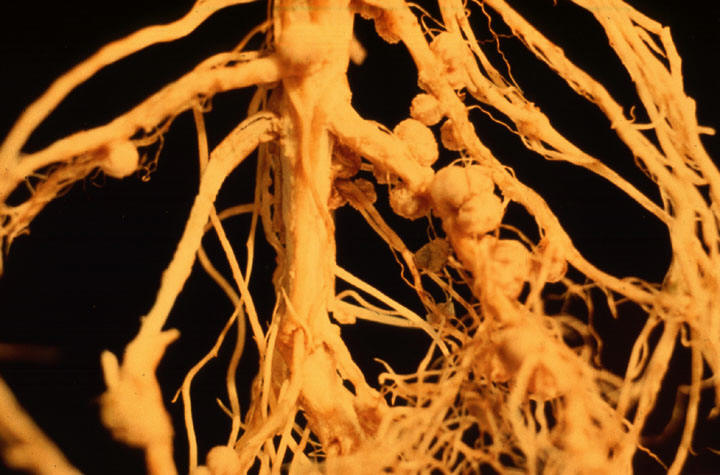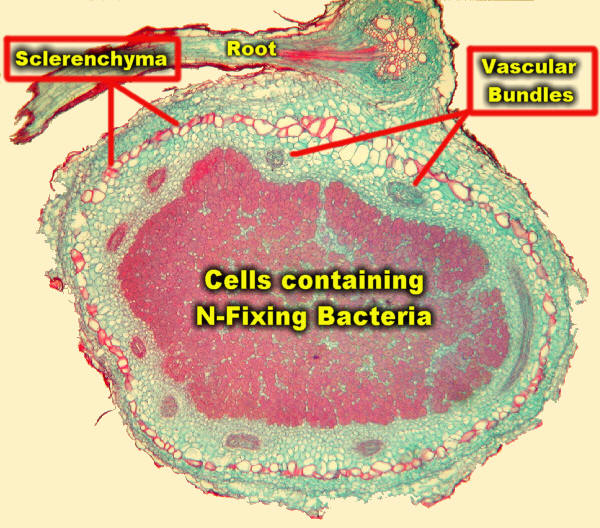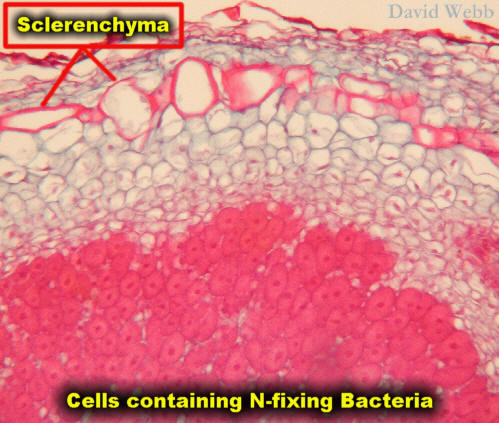Nodulation
Last updated on
February 23, 2014
Inoculation of soybean seeds with efficient strains of Rhizobium japonicum
bacteria enables the soybean plant to derive most of its N from the atmosphere.
Effective nodulation results in higher yields and more protein and oil per acre,
although percentages of oil and protein change very little.



Nodule development
Nodule initiation
- begins in soybean seedlings as soon as root hairs are present on primary roots or
branch roots.
- The root secrets tryptophan (an amino acid) and other compounds which stimulate
rapid growth of nodule bacteria and other soil microbes in the root rhizosphere.
- The bacteria convert tryptophan into indole acetic acid (iaa), which causes the
root hair to bend just prior to bacteria entering the root hair.
Infection thread formation
- As the bacteria enter the root hair (epidermal cells), an infection thread
is formed by the cytoplasm of the host cell.
- The formation of the thread in the epidermal cell causes the cell to enlarge.
- The infection thread then forms in the outer layer of cortical cells.
- The infection thread usually penetrates 25 layers of cortical cells, but never penetrates
the endodermis or pericycle.
- The infection thread may branch extensively in the cortical cells.
Bacteria enter the host cells by passing through thin spots in the infection thread.
Bacteria now referred to as bacteroids.
- The bacteria in the host cells undergo rapid division for about 2 weeks. The host
cells also divide rapidly during this time, causing the infection thread to disappear.
- Bacterial division slows after 2 weeks, and after 3 weeks it has stopped entirely.
From this point on the bacteria are referred to as bacteroids.
- Cell division also stops at this point, but the nodule continues to grow for another
2 weeks by cell enlargement.
- After initial infection by the bacteria, there is a gradual buildup of a pigment
called leghemoglobin, which gives the infected tissue a pink coloration that is
maintained until nodule breakdown.
- During the buildup of leghemoglobin, which keeps the system free of oxygen, and
as bacterial division is ceasing, N fixation begins. N fixation occurs because a
N fixing enzyme, nitrogenase, forms in the bacteriods and facilitates the following
reaction: N2 nitrogenase NH3 aa's, protein
N fixation begins about 2 to 3 weeks after initial rhizobial infection. After 8 weeks,
the nodules begin to degenerate.
- It is aided by bacteroids, in which nitrogenase forms. N fixation usually
occurs during the 3rd through the 8th week after nodule formation
was initiated.
N2 fixation in the soybean plant infected with bacteria is symbiotic
because the soybean variety must be susceptible to nodulation the strain
of Rhizobium japonicum which must be able to induce nodulation (must be virulent)
Inoculation
- Inoculation usually is recommended as a protective measure because it is
relatively inexpensive, but it is not always necessary.
- Inoculation almost always increases yields when soybeans are grown on soils where
they were never grown previously.
- Inoculated soybeans grown in soils where soybeans have been grown in the past (especially
the past 45 years) usually do not have higher yields than noninoculated soybeans.
- Inoculation does not seem necessary as a regular practice in fields where well nodulated
crops of soybeans have been grown during the past 35 years.
- However, many soybean growers inoculate each year because it is relatively inexpensive
|